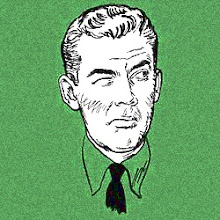My son and I watched one of the top pop 30 films of 1960 tonight,
Atomic Submarine. It was actually released in 1959 but made the '60 charts.
The director Spencer Gordon Bennet later noted that the film was influenced by the news of the
voyage of Nautilus sub under the North Pole but that doesn't begin to account for this strange yet simple sci fi flick with political - or, more accurately, anti-political - overtones.

It's 1968 or so - anyway, 1960's version of 1968 - and by this point (in the future, I mean) the path under the pole has become a main thoroughfare (for reasons not explained--was there a demand for weeks-long passenger travel to Lapland and Siberia?) but this commerce has been disrupted by strange occurrences: ships of all kinds have been destroyed and disappeared. The attacks leave high levels of radiation. Back in Washington, scientists and the president's men are concerned. The best sub and the best captain are to be sent to the North Pole to seek out this unknown enemy and destroy it. The commander is "Reef" Holloway, a surprisingly relaxed fellow. The captain is Dan Wendover (played by Dick Foran, whose acting is truly wooden); Dan is enjoying a liaison in his apartment with a blonde bombshell when a note is slipped under the door, telling him to drop everything and go immediately to his beloved sub. On board, Dan is told that he must share his cabin with Dr. Neilson; he doesn't mind, as Neilson is a distinguished WW2 hero whom Dan admires. But when he steps into the cabin, there's instead a young, swarthy, handsome and skeptical-looking man there. We know instantly that there's trouble: for one thing, the music swells disharmoniously; for another, Dan (whose love of blonde bombshells and instant responses to his commander's call are both signs that he's a normative voice) obviously loathes the young man.

The young man turns out to be the hero Neilson's son. The father and son work together on an experimental mini-submersible capsule that apparently is needed on this adventure; the elder Neilson was felled by a minor heart attack and the son, played by Brett Halsey, must take his place (as the only other person on the planet who can operate the capsule).
Between Dan's conversations with other buddies, and the awkward voiceover narrator, we learn that the son is peacenik: he has opposed all war and apparently calls for negotiation with the Soviets (although that enemy is not mentioned explicitly--as it often is not in cold-war-era sci fi when
other alien enemies stand in as analogies). The career of the war-hero father, we learn, has been cut short by the PR fiasco associated with the son's radical views. This is bad, bad, bad, and Dan cannot understand (thus neither can we) why a person with such views would be on this voyage. There are plenty of 50s-era sci fi films in which such a character - almost always dark-haired and swarthy - would turn out to be a "alien symp," a dupe who does the bidding of the little green men (in this case a furry tentacled super-intelligent cyclops who travels in an organic flying saucer) who want to take over the earth. But not here. There are a few moments when the camera focuses on the Brett Halsey's face, just when we are being asked to wonder who the real enemy is. But this never adds up to anything. In a way that's a relief, but what, then, is the purpose of this character?
Halsey's Dr. Neilson argues ideology with Dan ("We must give peace a chance"; "You fool, these enemies only know force"), but then the young dove reminds the captain that someone of his views can still be strong and principled and brave. Dan doesn't believe it, but when Dr. Neilson and Dan are the two mainly responsible for holding off the cyclops-like creature from outerspace it becomes clear that bravery trumps ideology any day. The evil creature is destroyed by an ICBM missile launched from the submarine and the world is saved. (It's a darned good thing America permitted itself to arm its subs with ICBM's. These are long-range missles and the cyclops was 100 feet away, but never mind.)
So in the final scene we're back in the U.S. of A., and Neilson and Dan are leaving the ship together. Shake hands; one last quick conversation. They like each other now, despite their opposing world views (as it were). Dan makes a wisecrack about having left his "little black book" on the alien's flying saucer, and Neilson very much appreciates this tragedy, so he's come a long way over to Dan's side. Maybe both of them will have blondes awaiting them ashore.
A conservative sci fi film would, as I say, have found Dr. Neilson guilty (the doctorate is almost always a bad sign) of sympathy or even collaboration with the enemy Other, or have him killed by said enemy after naively trying to deal with it. Liberal-centrist cold-war sci fi almost always enables us to see a Neilson type as redeemable - able to set his political ideas aside and see the value of use of force and the true beautiful humanity in each and every hawk (such as Don here).

Brett Halsey was an interesting choice for this role, for two reasons. First, he was known just then for roles in cheapjack James Dean-style motorcycle deliquent flicks (
Hot Rod Rumble, High School Hellcats, Speed Crazy), so here on the submarine, with his pacifist ideas, he had an aura of irrelevant adolescence about him. Second, this young handsome actor was in real life the son of a great WW2-era military hero, William F. Halsey ("Bull" Halsey), commander of the Pacific Allied naval forces in the war. I don't suppose there's a

real biographical parallel, but the symbolism is good enough to interest me, for in one sense the film enacts Hollywood's sense of these two generations, that of the Good War warrior and that of the beatnik whose eccentric notions of America's role in the world arose in the affluence made possible by the way the Good War had been fought by the fathers. Fathers and sons. All the fathers and some of the sons. A tale of two generations, perfect for telling from the p.o.v. of 1960: from military-hero father to beefcake bit-part hotrod movie type; from the real man of the Greatest Generation to the Beat-era know-nothing Teen; from martial honor to peacenik. No wonder we are losing the war against the Russians. Hawks and doves bond over little black books but will not try to come together on political philosophy.
The movie doesn't deal with political difference so much as sets it aside in the natural course of staving off real enemies. The sons are not our real enemies; they've deluded themselves into thinking they disagree. Political difference is not relevant in a world being attacked by the Ultimate Enemy. And finally, natural commerce--to restore which was the reason for the rescue mission--in this new enterprise zone can bustle once again: that presumably profitable traffic going back and forth under the North Pole. All is well.
 In one scene, Claudia and Sandro are in a small village; while Sandro goes looking for Anna is a (literally) hole-in-the-wall hotel, Claudia waits for him outside that wall, as the men of the town slowly circle around her, wordlessly staring.
In one scene, Claudia and Sandro are in a small village; while Sandro goes looking for Anna is a (literally) hole-in-the-wall hotel, Claudia waits for him outside that wall, as the men of the town slowly circle around her, wordlessly staring.


















































 Is '60 the moment when the end of the end of the Old Left had been reached and the New Left began to emerge? Is it the final ascendancy, in certain scenes at least, of poetic postmodernity? Surely the publication of Donald Allen's The New American Poetry that year suggests this, but then again--once again--we look back on "New" here and see continuity. The rhetoric of the Kennedy-Nixon contest made much less of a dent than everyone (at the time as well as since) claimed, so one wonders why were such great claims made?
Is '60 the moment when the end of the end of the Old Left had been reached and the New Left began to emerge? Is it the final ascendancy, in certain scenes at least, of poetic postmodernity? Surely the publication of Donald Allen's The New American Poetry that year suggests this, but then again--once again--we look back on "New" here and see continuity. The rhetoric of the Kennedy-Nixon contest made much less of a dent than everyone (at the time as well as since) claimed, so one wonders why were such great claims made?  Had we come to expect "1960" to be truly ubiquitously modern in a way that the 1950s really were not--not quite? And what specifically does "modern" mean in the Kennedyesque talk then and now about the torch being passed to a new generation, etc.? The First Lady really meant "modernist" when Camelotians said "modern." What about the others across the new young cultural leadership? I've been surprised by how frequently the
Had we come to expect "1960" to be truly ubiquitously modern in a way that the 1950s really were not--not quite? And what specifically does "modern" mean in the Kennedyesque talk then and now about the torch being passed to a new generation, etc.? The First Lady really meant "modernist" when Camelotians said "modern." What about the others across the new young cultural leadership? I've been surprised by how frequently the  "Beat movement" was covered in 1960 in the mainstream press. I was expecting a fair measure but I've found tonnage. 1960 was the year when the figure of the beat was beginning to find acceptance, although still 80% of these stories are mocking, rebels-without-cause condescension. For anyone whose analysis made an impact nationally, do these antipolitical adolescents count as part of the "new young cultural leadership"? No, but rather than the two being opposites, they fall along a Continuum of the New American. Now that's a change for '60.
"Beat movement" was covered in 1960 in the mainstream press. I was expecting a fair measure but I've found tonnage. 1960 was the year when the figure of the beat was beginning to find acceptance, although still 80% of these stories are mocking, rebels-without-cause condescension. For anyone whose analysis made an impact nationally, do these antipolitical adolescents count as part of the "new young cultural leadership"? No, but rather than the two being opposites, they fall along a Continuum of the New American. Now that's a change for '60.







